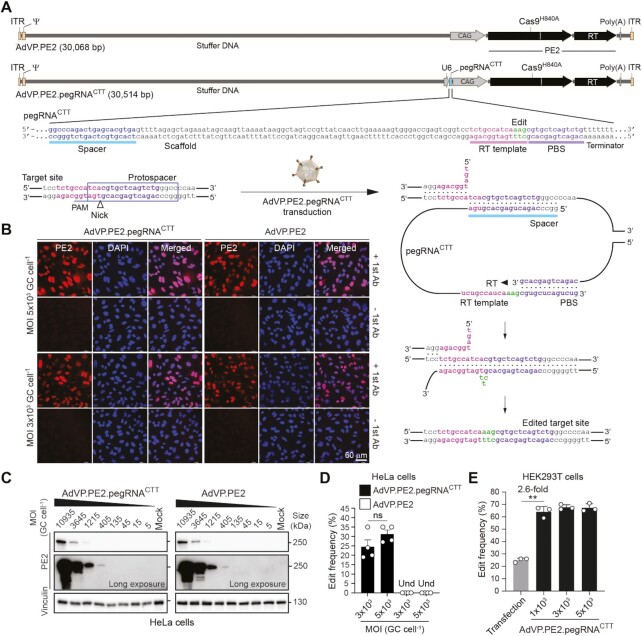Figure 1.
Efficient prime editing in human cells through all-in-one AdVP delivery. (A) Schematics of AdVP genomes encoding PE elements. AdVP.PE2 and AdVP.PE2.pegRNACTT express only PE2 and PE2:pegRNACTT complexes, respectively. The pegRNACTT installs a CTT insertion at the long non-coding RNA gene LINC01509 once coupled to PE2. Hybrid CAG and human U6 promoters drive PE2 and pegRNACTT synthesis, respectively. The pegRNACTT coding sequence is depicted with the respective components highlighted, i.e., sequence-specific spacer, scaffold, primer binding site (PBS) and RT template with embedded edit. A schematics of target site engagement and editing by a PE2:pegRNACTT complex is equally shown. PAM, protospacer adjacent motif (NGG). (B and C) Analyses of PE2 expression in transformed cells. HeLa cells were transduced with AdVP.PE2.pegRNACTT or AdVP.PE2 at the indicated multiplicities-of-infection (MOI). PE2 was detected by immunofluorescence microscopy (panel B) and western blotting (panel C) at 2 days post-transduction. Cas9- and vinculin-specific antibodies served for detecting target (PE2) and loading control proteins, respectively. (D and E) Detection of prime editing in transformed cells. Cervical carcinoma HeLa cells and human embryonic kidney HEK293T cells were transduced with the indicated AdVPs at different MOI (panels D and E, respectively). At 3 days post-transduction, prime editing activities were assessed by target site genotyping assays. HEK293T cells were also co-transfected with plasmids encoding PE2 and pegRNACTT. GC cell–1, vector genome copies per cell. Und, undetected. Graphs in panels D and E present mean ± s.e.m. (n = 4) and mean ± s.d. (n = 3), respectively. Statistical significance between the indicated datasets was assessed with two-tailed Student's t tests; **0.001 < P< 0.01; P > 0.05 was considered non-significant (ns).

